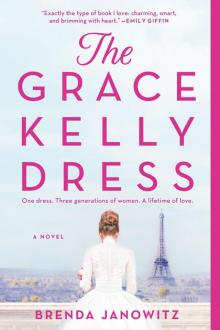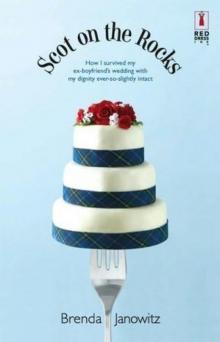- Home
- Brenda Janowitz
The Grace Kelly Dress
The Grace Kelly Dress Read online
Two years after Grace Kelly’s royal wedding, her iconic dress is still all the rage in Paris—and one replica, and the secrets it carries, will inspire three generations of women to forge their own paths in life and in love.
Paris, 1958: Rose, a seamstress at a fashionable atelier, has been entrusted with sewing a Grace Kelly–look-alike gown for a wealthy bride-to-be. But when, against better judgment, she finds herself falling in love with the bride’s handsome brother, Rose must make an impossible choice, one that could put all she’s worked for at risk: love, security and of course, the dress.
Sixty years later, tech CEO Rachel, who goes by the childhood nickname “Rocky,” has inherited the dress for her upcoming wedding in New York City. But there’s just one problem: Rocky doesn’t want to wear it. A family heirloom dating back to the 1950s, the dress just isn’t her. Rocky knows this admission will break her mother Joan’s heart. But what she doesn’t know is why Joan insists on the dress—or the tragic secret that changed her mother’s life decades before, as she herself prepared to wear it.
As the lives of these three women come together in surprising ways, the revelation of the dress’s history collides with long-buried family heartaches. And in the lead-up to Rocky’s wedding, they’ll have to confront the past before they can embrace the beautiful possibilities of the future.
Brenda Janowitz is the author of five novels, including The Dinner Party and Recipe for a Happy Life. She is the books correspondent for PopSugar. Brenda’s work has also appeared in the New York Times, USA TODAY, the Washington Post, Salon, Redbook and the New York Post. She lives in New York.
Find Brenda on Twitter, @brendajanowitz, and on Instagram, @brendajanowitzwriter.
BrendaJanowitz.com
Also by Brenda Janowitz
The Dinner Party
Recipe for a Happy Life
The Lonely Hearts Club
Scot on the Rocks
Jack with a Twist
The Grace Kelly Dress
A Novel
Brenda Janowitz
To Doug, Ben and Davey, always
Contents
Quote
Part One
One
Two
Three
Four
Five
Six
Seven
Eight
Nine
Ten
Eleven
Twelve
Thirteen
Fourteen
Fifteen
Sixteen
Seventeen
Eighteen
Nineteen
Twenty
Twenty-One
Part Two
Twenty-Two
Twenty-Three
Twenty-Four
Twenty-Five
Twenty-Six
Twenty-Seven
Twenty-Eight
Twenty-Nine
Thirty
Thirty-One
Thirty-Two
Thirty-Three
Part Three
Thirty-Four
Thirty-Five
Thirty-Six
Thirty-Seven
Thirty-Eight
Thirty-Nine
Forty
Forty-One
Forty-Two
Forty-Three
Forty-Four
Forty-Five
Forty-Six
Forty-Seven
Forty-Eight
Part Four
Forty-Nine
Fifty
Fifty-One
Fifty-Two
Fifty-Three
Fifty-Four
Fifty-Five
Fifty-Six
Fifty-Seven
Fifty-Eight
Fifty-Nine
Sixty
Sixty-One
Sixty-Two
Sixty-Three
Sixty-Four
Sixty-Five
Sixty-Six
Sixty-Seven
Sixty-Eight
Sixty-Nine
Seventy
Seventy-One
Seventy-Two
Acknowledgments
Questions For Discussion
“Our life dictates a certain kind of wardrobe.”
—Grace Kelly
PART ONE:
PICK YOUR PATTERN
“When designing a wedding dress, the first step is to decide on a pattern. Do not make this decision lightly. This is the most important step, as all other decisions you make will flow from this very first choice. This dress is the most important dress a bride will ever wear. Choose carefully.”
—Excerpted from Creating the Illusion by Madame Michel,
Paris, 1954
One
The bride
Brooklyn, 2020
She hated the dress. She did not really like the veil that went with it, either. Yes, she understood that it was made of rose point lace, the same type of lace that was used on Princess Grace’s wedding dress, the most iconic wedding dress of all time, but no, that did not sway her opinion.
She did not want to wear any wedding dress, for that matter. She thought that wedding dresses were stupid and overly expensive and a symbol of the patriarchy and a million other things her mother just would not understand. But she could never say any of those things to her mother. Especially since it was her dress that they were talking about. The dress Joan proudly wore down the aisle on her wedding day. The dress that was passed down to her by her mother, Rocky’s grandmother.
How could a girl tell her mother that she didn’t want to wear that dress?
Rocky wiped her hands on her black jeans as she puzzled over what to do, what to say. Perhaps she should just be honest with her mother, tell her the truth. This could end right here and now.
She could hear her father’s gentle laughter echo in her mind. She didn’t need to speak to him to know what his reaction would be: Is that the plan, Kitten? No, that wouldn’t work. That wouldn’t work at all.
Rocky took a deep breath as she arrived at the bridal boutique. This salon was the one her mother had picked out, of course, not the one Rocky had wanted. But she could never say no to her mother.
Rocky slowly opened the door, so slowly, as if she were afraid to walk in (wasn’t she, though?), and a gentle chime rang out. Her father was right: she would need a strategy to tell her mother the truth. She couldn’t just blurt it out. She’d have to visit her father this week. He’d help her come up with a plan.
“This is my daughter, Rachel,” Joan said, beaming with pride as Rocky entered. Rocky felt like Dorothy, walking into Oz and seeing things in color for the first time. It was as if the streets of Brooklyn, where she lived and worked, were sepia tones, and the bridal shop, a store she’d walked by hundreds of times without noticing, was in full Technicolor. Rainbows bounced off the tiaras in the display case onto the mannequins wearing wedding dresses in delicate shades of white, ivory, and blush. There were ribbons, and tulle, and taffeta, oh my!
“Rocky,” her daughter corrected her, arm extended for a handshake. The old woman standing next to her mother regarded her, arms carefully folded across her chest. She examined Rocky from the tips of her toes to the top of her head and then offered a small smile in return. “I’m Greta.”
“Oh, yes,” Joan said. “I was just getting to that. She likes to be called Rocky. Rocky, Greta. Greta, Rocky.” And then, sotto voce, she delivered her usual line: “It wo
uld make more sense if her name was Raquel, but who am I to judge?”
Truth was, they’d been calling her Rocky since the third grade, and it had nothing to do with the fact that her given name was Rachel. They named her “Rocky” one day at recess, after she punched Jimmy Timbers squarely in the nose for calling her sister, Amanda, a dyke.
Joan put her arm around Rocky’s shoulders as they walked towards the back of the salon. “Did you need to wear combat boots into a bridal boutique?” she whispered.
“They’re motorcycle boots,” Rocky said, and then looked down at her feet, as if to prove it were true. She glanced down at her mother’s shoes: pale pink ballerinas.
“Combat, motorcycle,” Joan said. “Same difference. Wouldn’t it be lovely to wear a nice pair of heels for a change?”
“These are my dressy motorcycle boots.”
“Shall we get the dress on?” Greta asked, and Rocky couldn’t help but think: What, no foreplay? We’re just doing this? But she simply allowed herself to be led to the slaughter. Which is to say: a fitting room where she would be forced to strip down, nearly naked, in front of her mother and Greta and try on a dress she had no intention of wearing.
“She’s going to dye her hair back to brown for the wedding,” Joan said to Greta, as she pulled the bodice onto her daughter’s lithe frame. She pressed her hands to Rocky’s waist, to show her what it would look like once it was tailored to fit her body. The dress had been made for someone with more of an hourglass figure, someone more like her sister, Amanda, and everyone knew it. But no one would say it. No one would dare say it.
Rocky wanted to say something about her hair color—she was not planning to dye it back to brown for her wedding day—but she couldn’t get the words out.
“Great,” Greta said, as she slowly helped Rocky step into the skirt of the dress. Greta’s hands showed her age, and Rocky didn’t want her bending over and straining herself on her behalf. She looked to be around the same age as Rocky’s grandmother. Rocky wanted to tell Greta that she could do it on her own, but then reconsidered. Would it offend her if Rocky offered to do it on her own? Greta was old, but she moved as if she were a young woman, as if nothing could kill her. “We’ll use these clips to get a sense of what it will look like once it’s been tailored.”
“Oh, Greta,” Joan said, as the woman stepped back to admire her handiwork.
With the aid of the clips, the dress actually fit. Rocky gave her short hair, cut into a messy shag and dyed dark green this week, a tousle, and looked at herself. She didn’t look terrible. That much she had to admit. But there was something bothering her, something she couldn’t put her finger on.
Her eyes traveled down her body. The rose point lace was beautiful, just as her mother had described. Rocky had never been the one to try on her mother’s wedding dress as a child—that was Amanda’s department—so she was pleased to see that it wasn’t quite as outdated as she thought it might be. Although the Princess Diana sleeves—an update added by her mother in the ’80s—would have to go. The dress had a fitted bodice, a cummerbund made of thick layers of silk on the waist, and a full skirt done in silk faille. Three skirts, actually, if you included the skirt support, silk skirt with ruffled petticoat, and train insert.
“Do you need a pair of shoes to put on?” Greta asked, holding out a pair of sling-backs.
And there it was. She might have looked all right—nice, even—but she didn’t look like herself. She never wore dresses, for one, and even if she did, she would never wear white. And the way her mother was holding down the voluminous sleeves of the dress made it clear that she was happy that, at just under elbow length, they would cover up her tattoos. But Rocky was proud of her tattoos. They told her story, one by one. She tugged up the sleeve to reveal one of her favorite tattoos just below the crook of her right elbow. The name of her fiancé, written in script. Drew had a matching one on his arm, in the same spot. It was the seventh tattoo she ever got, inked on the day they moved in together. Lucky number seven.
Greta’s hand went to the inside of her own arm, and ran her fingers over it. She stared at Rocky’s tattoo, seemingly transfixed by it. Rocky’s mother caught a glimpse of Greta’s expression in the full-length mirror and tugged the sleeve back down. Rocky rolled her eyes—Greta, like her mother, could not possibly understand why her tattoos were important to her.
“Give me your phone,” Joan said. “I’ll take a picture.”
“I don’t think—” Rocky began.
“The groom must not see his bride in the wedding dress,” Greta cut in. “These kids with phones in clouds, nothing stays private.”
“Good point.” Joan nodded. “We don’t want any chance that Drew might see it. Thank you, Greta.”
Rocky saw a flash go off; Joan had taken a photo with her own iPhone, an old 6 model that Rocky had begged her to replace. (She made a mental note to get her mother the newest phone for Christmas that year.)
Rocky imagined Drew’s reaction to her in the dress. He’d never seen her in a dress, had he? The closest he’d ever come was looking at the old family photo albums Joan kept in her living room, catching a glimpse of the matching dresses Joan would insist that the girls wear for Thanksgiving. (Even though Amanda was two years older, people were always mistaking Rocky and her sister for twins, with their matching dark green eyes and heart-shaped faces.) One year, they even wore white tights with turkeys printed on the ankles. Joan was so proud of finding those tights with the turkeys, each one with a rhinestone for an eye. Amanda loved wearing matching dresses, but Rocky loathed it. Each year, her father would bribe her to go along with it by letting her eat doughnuts for breakfast as they watched the Thanksgiving Day parade on the television.
Maybe Drew would like seeing Rocky in the dress. He loved the traditions shared by his large Jewish family, even though he, himself, was adopted from South Korea. He kept his father’s tallit, gifted to him on his Bar Mitzvah day, in a special velvet bag on the top shelf of their closet. When a neighbor told him of a flood in their apartment, he immediately ran to the Container Store to get a plastic box, in which to keep the prayer shawl even more safe.
So maybe the idea of a dress passed down from grandmother to mother to daughter would appeal to Drew. But aren’t you supposed to look like yourself on your wedding day? That’s what the bridal magazines Amanda had been buying for her said: a bride should look like the best version of herself on her wedding day. It is the day when you announce to the world that you are becoming part of a team. Shouldn’t you be yourself for that?
She didn’t look like herself.
“A wedding dress passed down three generations,” Greta said, breathless. “How special. It would be my honor to work on the restoration of this dress.”
Rocky did not want to wear the dress. But what to say?
Two
The mother of the bride, as a bride herself
Long Island, 1982
She loved the dress. She loved the veil that went with it, too, though she wasn’t sure if it could be salvaged. It was showing signs of age, its edges curling and tinged with brown. But that wouldn’t dull her excitement.
Today was the day she would be trying on her mother’s wedding dress. Even though Joanie had tried it on countless times as a child—it was a favorite rainy-day activity with her mother—today felt different. She was engaged, just like she’d dreamed about ever since she could remember. When she tried the dress on this time, it was for keeps. She was completely in love with the dress.
“Let me help you get it on,” Joanie’s mother said, her French accent coming through. It was always more pronounced when she was feeling emotional. With her American friends, Joanie noticed, her mother always tried to sound “American,” softening her accent and using American expressions. But when they were alone, she could be herself. Let her guard down. Joanie knew exactly who her mother was, and she loved her for it.
Her mother handed Joanie a pair of white cotton gloves and then put on her own set. The first step in trying the dress on, always, so that the oils in their hands wouldn’t defile the fabric. She laid the large box on her bed and nodded her head at her husband, her signal to give them privacy. The door closed to Joanie’s childhood bedroom, and she and her mother were alone.
The white cotton gloves were cool and smooth on her skin. Joanie opened the box slowly. So slowly. It was sealed with a special plastic that was supposed to keep it airtight so that the dress would not oxidize and turn yellow. She and her mother laughed as they struggled to set the dress free. The last time she tried the dress on was the summer before her sister died. It was after Michele’s death that her mother brought the dress into the city so that it might be cleaned properly and preserved for just this day. At the time, Joanie hadn’t understood the connection between her sister’s sudden death and her mother’s tight grip on family heirlooms, but now, a year into her psychology degree at NYC University, she understood. It was so hard to hold on to things that were important to you, things that mattered, and preserving her wedding dress, this memory, was her mother’s way of taking control of something. It was something she could save.
The dress was just as beautiful as she’d remembered. Crafted from rose point lace, the same lace used on Grace Kelly’s iconic wedding dress, it was delicate and classic and chic and a million other things Joanie couldn’t even articulate.
“Go on,” her mother said, holding the first part of the dress—the bodice with the attached underbodice, skirt support, and slip—out for her to take. As a child, it had thrilled Joanie to no end that the wedding dress her mother wore was actually made up of four separate pieces. It was like a secret that a bride could have on her special day, something that no one else knew.
“I couldn’t,” Joanie said, hands at her side. Knowing how carefully preserved the dress had been, what the dress had meant to her mother, it was hard for Joanie to touch it. She didn’t want to get it dirty, sully its memory. “It’s just so beautiful.”

 The Grace Kelly Dress
The Grace Kelly Dress Scot on the Rocks
Scot on the Rocks Scot on the Rocks bm-1
Scot on the Rocks bm-1 The Lonely Hearts Club
The Lonely Hearts Club Jack With a Twist bm-2
Jack With a Twist bm-2 Based On A True Story (brooke miller)
Based On A True Story (brooke miller) The Dinner Party: A Novel
The Dinner Party: A Novel Mon fiancé, sa mère et moi
Mon fiancé, sa mère et moi Hollywood Punch
Hollywood Punch